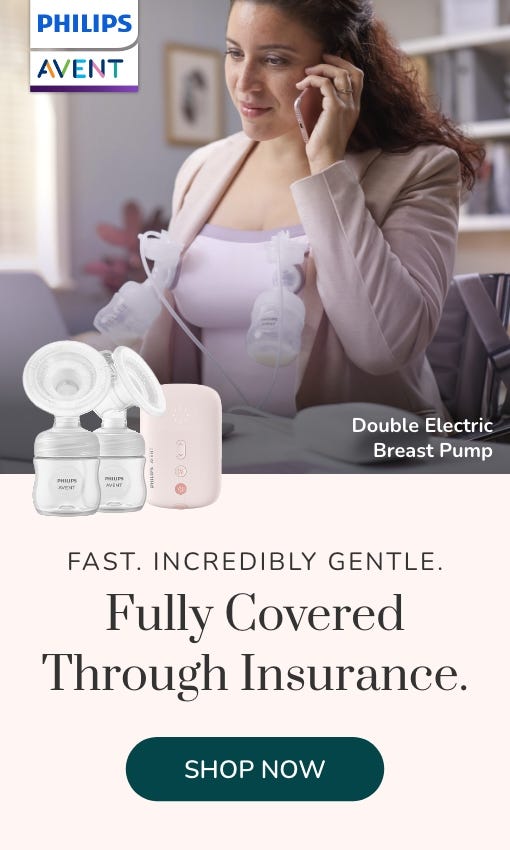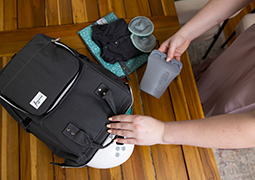-

Momcozy M9 Mobile Flow Hands-free Breast Pump
These items are partially covered by your insurance and a small co-pay or deductible will be due at time of checkout. If you have a secondary insurance, please contact our customer success team as secondary insurance may result in these items being fully covered.$269.99 -

Motif Luna Breast Pump with Wet-Dry Bag
These items are partially covered by your insurance and a small co-pay or deductible will be due at time of checkout. If you have a secondary insurance, please contact our customer success team as secondary insurance may result in these items being fully covered.$243.99 -

Motif Roam Breast Pump
These items are partially covered by your insurance and a small co-pay or deductible will be due at time of checkout. If you have a secondary insurance, please contact our customer success team as secondary insurance may result in these items being fully covered.$189.00 -

Motif Duo Breast Pump with Hands-Free Pumping Bra
These items are partially covered by your insurance and a small co-pay or deductible will be due at time of checkout. If you have a secondary insurance, please contact our customer success team as secondary insurance may result in these items being fully covered.As low as $199.00As low as $199.00As low as $199.00 -

Spectra S2 Plus Breast Pump with AFBP Sydney Breast Pump Backpack
These items are partially covered by your insurance and a small co-pay or deductible will be due at time of checkout. If you have a secondary insurance, please contact our customer success team as secondary insurance may result in these items being fully covered.As low as $201.99As low as $201.99As low as $201.99 -

Medela Pump In Style Hands-free Breast Pump
These items are partially covered by your insurance and a small co-pay or deductible will be due at time of checkout. If you have a secondary insurance, please contact our customer success team as secondary insurance may result in these items being fully covered.$199.99 -

Motif Aura Glow™ Wearable Breast Pump
These items are partially covered by your insurance and a small co-pay or deductible will be due at time of checkout. If you have a secondary insurance, please contact our customer success team as secondary insurance may result in these items being fully covered.$199.99 -

Momcozy M5 Wearable Breast Pump
These items are partially covered by your insurance and a small co-pay or deductible will be due at time of checkout. If you have a secondary insurance, please contact our customer success team as secondary insurance may result in these items being fully covered.$199.99 -

Spectra S1 Plus Breast Pump
These items are partially covered by your insurance and a small co-pay or deductible will be due at time of checkout. If you have a secondary insurance, please contact our customer success team as secondary insurance may result in these items being fully covered.$216.00 -

Medela Pump In Style Pro Breast Pump
These items are partially covered by your insurance and a small co-pay or deductible will be due at time of checkout. If you have a secondary insurance, please contact our customer success team as secondary insurance may result in these items being fully covered.$149.99 -

Elvie Stride Breast Pump
These items are partially covered by your insurance and a small co-pay or deductible will be due at time of checkout. If you have a secondary insurance, please contact our customer success team as secondary insurance may result in these items being fully covered.$269.99 -

Medela Swing Maxi Hands-free Breast Pump
These items are partially covered by your insurance and a small co-pay or deductible will be due at time of checkout. If you have a secondary insurance, please contact our customer success team as secondary insurance may result in these items being fully covered.$199.99 -

Momcozy M6 Mobile Style Hands-free Breast Pump
These items are partially covered by your insurance and a small co-pay or deductible will be due at time of checkout. If you have a secondary insurance, please contact our customer success team as secondary insurance may result in these items being fully covered.$229.99 -

Eufy S1 Pro Wearable Breast Pump
These items are partially covered by your insurance and a small co-pay or deductible will be due at time of checkout. If you have a secondary insurance, please contact our customer success team as secondary insurance may result in these items being fully covered.$349.99Out of stock -

Momcozy S9 Pro Wearable Breast Pump
These items are partially covered by your insurance and a small co-pay or deductible will be due at time of checkout. If you have a secondary insurance, please contact our customer success team as secondary insurance may result in these items being fully covered.$119.99 -

BabyBuddha 2.0 Breast Pump
These items are partially covered by your insurance and a small co-pay or deductible will be due at time of checkout. If you have a secondary insurance, please contact our customer success team as secondary insurance may result in these items being fully covered.$200.00 -

Willow Go Wearable Breast Pump
These items are partially covered by your insurance and a small co-pay or deductible will be due at time of checkout. If you have a secondary insurance, please contact our customer success team as secondary insurance may result in these items being fully covered.$349.99 -

Eufy S1 Wearable Breast Pump
These items are partially covered by your insurance and a small co-pay or deductible will be due at time of checkout. If you have a secondary insurance, please contact our customer success team as secondary insurance may result in these items being fully covered.$239.99Out of stock -

Lansinoh Thrive 2 in 1 Breast Pump
These items are partially covered by your insurance and a small co-pay or deductible will be due at time of checkout. If you have a secondary insurance, please contact our customer success team as secondary insurance may result in these items being fully covered.$159.99 -

Momcozy S12 Pro Wearable Breast Pump
These items are partially covered by your insurance and a small co-pay or deductible will be due at time of checkout. If you have a secondary insurance, please contact our customer success team as secondary insurance may result in these items being fully covered.$139.99 -

Lansinoh DiscreetDuo Wearable Breast Pump
These items are partially covered by your insurance and a small co-pay or deductible will be due at time of checkout. If you have a secondary insurance, please contact our customer success team as secondary insurance may result in these items being fully covered.$159.99 -

Philips Avent Breast Pump Advanced, Corded Use
These items are partially covered by your insurance and a small co-pay or deductible will be due at time of checkout. If you have a secondary insurance, please contact our customer success team as secondary insurance may result in these items being fully covered.$125.00 -

Elvie Pump Breast Pump
These items are partially covered by your insurance and a small co-pay or deductible will be due at time of checkout. If you have a secondary insurance, please contact our customer success team as secondary insurance may result in these items being fully covered.$549.99
What Are the Different Types of Breast Pumps?
There are four main types of breast pumps:
Electric Breast Pump
Typically the most powerful breast pumps available, electric breast pumps are generally required to be plugged into a wall outlet. They are available either as a double electric breast pump or a single electric model. The difference being that double electric models support expression from both breasts at once whereas a single electric only allows you to express milk from one breast at a time.
Battery-Operated Breast Pump
Similar in functionality to electric breast pumps, battery-operated breast pumps are characterized most notably by their portability. By being powered with a battery, they are also often considered hands-free breast pumps. While there are some tradeoffs in terms of suction power, these breast pumps are popular options for those who need to pump while at work, anywhere on the go, or in situations where they don't have access to a wall outlet.
Manual Breast Pump
These breast pumps require manual hand operation to create the suction required to express milk. While manual breast pumps don't include as many features as electric models, they are often lightweight, easy to transport, and very affordable.
Hospital-Grade Breast Pump
This type of breast pump is generally designed to be a multi-user, rental-based breast pump. Those who generally benefit from hospital-grade breast pumps most are mothers who are experiencing a specific type of medical event that prevents direct breastfeeding with their babies. Situationally, these can include NICU stays, the birth of multiples, mastitis, and other difficulties breastfeeding.
How Much Does a Breast Pump Cost Without Insurance?
The typical out of pocket cost for a breast pump is usually between $150 - $500 for an electric breast pump while a manual breast pump could be as little as $15. As such, the out of pocket cost of a breast pump can vary based on the type of pump you choose.
Many parents are unaware that the cost of a breast pump may be covered through insurance under the Affordable Care Act. To find out more about your specific coverage, fill out our insurance eligibility form with your basic health insurance information.
What Are the Top Breast Pump Brands?
Aeroflow Breastpumps carries only the industry’s best and most popular breast pumps. These top-selling breast pump brands include:
Which Breast Pumps Are Hospital-Grade?
Hospital-grade breast pumps are used by mothers of NICU babies or when medical issues may hinder mom & baby’s ability to successfully breastfeed. Breast pumps that are hospital-grade are specifically designed for multiple users, with a special closed system that makes the pump safe for moms to share. Aeroflow Breastpumps currently offers the Medela Symphony – this hospital-grade pump is only available for rent when covered by insurance, and requires a prescription.
What Is Breast Pump Suction?
Breast pump suction or power (documented as mmHG) refers to the speed at which the vacuum is applied to the nipple for breastfeeding. Breast pumps come with different strength levels and generally the speed at which you pump can be adjusted to accommodate your personal pumping needs.
How Fast Should Breast Milk Be Pumped?
Most breast pumps offer various settings to adjust how fast your milk is expressed. A typical pumping session takes around 15-20 minutes, but some mothers may spend closer to 30 minutes to fully express their breast milk. Your breast milk supply during each pumping sessions varies based on your baby's age, time of day, how often you pump or feed, the quality of your pump, diet, and more.
What Flange Sizes Come With Breast Pumps?
Using the correct flange size (also known as a breast shields) is incredibly important for adequate suction, optimal milk production, and comfort when pumping. There are five main breast pump flange sizes – 21, 24, 27, 30 and 36mm. The most effective flange should be within 2-3mm of your nipple size. The size(s) included with each pump will vary but should be listed in what is included and in the pump’s manual.
Is It Painful To Use a Breast Pump?
Just like with breastfeeding, using a breast pump should not be painful or uncomfortable. The sensation of pumping should be similar to comfortable breastfeeding: some pressure and gentle tugging. If you are experiencing pain or discomfort, it could indicate that something needs to be adjusted or resized. If pain persists, never hesitate to reach out to your healthcare provider or a lactation consultant.


